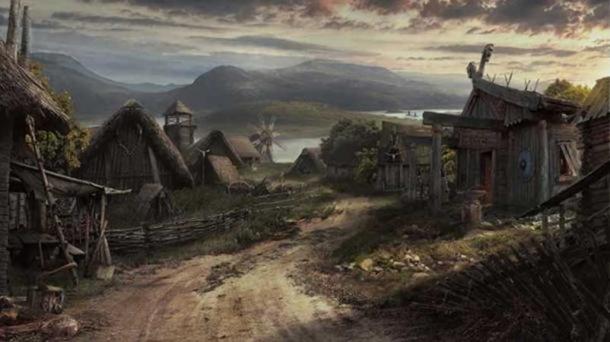
Why Would You Cremate and Bury Your Home? A Bizarre Viking Ritual Explained
The Vikings had a very bizarre tradition that might be totally unique: they buried their own homes. From the Bronze Age until the Viking Age, historians have noted that burial mounds were placed on top of the remains of Viking longhouses. The internal posts that served as roof-supporting beams were usually taken off before the house was set on fire and once the house had burned to the ground, one or more burial mounds were positioned on top of its remnants.
Vikings Burnt and Buried Their Own Houses
As Heritage Daily reports, Marianne Hem Eriksen, a postdoc at the Department of Archaeology, Conservation and History at the University of Oslo has investigated these uncommon “deaths” and burials of Scandinavian longhouses for quite some time now. She says, “I studied seven different house burials from the Iron Age in Scandinavia, in five different locations: Högom in Sweden; Ullandhaug in Rogaland; Brista in Uppland, Sweden; Jarlsberg in Vestfold; and Engelaug in Hedmark.”
- Viking Longhouse Discovery Rewrites the History of Icelandic Capital City
- Analysis of Viking burial site reveals the harshness of life in early Christian Iceland
Eriksen believes that the burial mounds were not always tied with human death, but instead they could possibly mark the cremation and burial of a house within Viking society. She explained to Heritage Daily, “In some cases we have been unable to find human remains, even in places where we could expect such remains to have been preserved. Nevertheless, archaeologists have more or less implicitly assumed that somewhere or other, there must be a deceased individual.”

Artist’s interpretation of a ‘Viking Village.’ (Lukasz Wiktorzak/ArtStation)
Living in a Typical Viking Longhouse
As Robin Whitlock suggests in a previous Ancient Origins article, a typical longhouse was a long and probably very chaotic structure, plagued by noise and dirt. This was primarily because a number of families tended to live in the same house along with their animals (that were kept at one end of the structure.) This area would also be where the crops were stored and it would have been separated into stalls for animals and crops. The fire was a source of heat and light, but there was no chimney and that meant the longhouse would have been very smoky. Sometimes, additional lighting was provided in the form of stone lamps with fish liver oil or whale oil as the fuel. Seating was either in the form of wooden benches along the walls or an available spot on the floor.
The walls of a longhouse were commonly made from a structure of wooden poles with wattle and daub infilling. In Denmark, some longhouses had forges inside them, although more commonly the forge was housed in a separate building. The size of the longhouse depended on the wealth of the owner and in some areas of Denmark royal longhouses were located in settlements within round earthen embankments consisting of four longhouses. Each longhouse accommodated the crew of a ship and their families. The roof was made of thatch or wooden shingles.

Reconstruction of a Viking house from the ring castle Fyrkat near Hobro, Denmark. (Malene Thyssen/CC BY SA 3.0)
Can a House Die?
The question popping up from such practices is simple: Can a house (or any object for that matter) die? Marianne Hem Eriksen had to dig deep into anthropology’s mysteries to find more sources about people’s attachment to their houses in various cultures. She told Heritage Daily,
“To people in Madagascar, a house has its own life cycle. It is born, lives, grows old and dies. The Batammaliba people of West Africa perform rituals during the construction of houses, the same rites of passage that they perform for newborn babies, adolescents and adults. When the house is completed, they perform a ritual where they ‘kill’ the house. The house has been alive during the building process, and must be killed to make it habitable for people. Many cultures believe that the house is metaphorically linked to the human body.”
- Researchers Wonder if Rich Viking Boat Burial Found in Scotland was Made for a Warrior Woman
- Evidence for Vikings in Canada Grows with Surprising Find of Ironworking Site in Newfoundland
The Link Between Human Bodies and Objects in Viking Culture
After years of research and study on the topic, Eriksen is pretty convinced that the Vikings saw a link between the human body and the house they were living in during their lifetime. As she told Heritage Daily:
“Many of the Norse words that are related to houses are derived from the human body. The word window comes from wind and eye and refers to openings in the walls where the wind comes in. The word gable, i.e. the top of the end wall of the house, means head or skull. This connection between bodies and houses may have led them to think that a house has some kind of essence, some kind of soul.”

‘Viking Long house door. Norway, Epcot Center.’ (One Lucky Guy/CC BY NC SA 2.0)
This possibly explains why Norse people during that period would often give their house a proper funeral when it had completed its circle of life. As Eriksen explained:
“By burning down the house they may have had a wish to cremate it, to liberate the life force of the house. If houses and people could be part of a network that had ‘agency’ – vitality and personality – this could at least be part of the explanation for the longevity of longhouses in Scandinavia.”
Eriksen is currently continuing her study on the topic and has published an article on the same in the European Journal of Archaeology.

Viking Longhouse – Reconstruction. (Eric Gross/CC BY 2.0)
Top Image: ‘Light and Structure’ - Reconstruction of Viking Longhouse: Central Jutland, Denmark. Source: Eric Gross/CC BY 2.0















